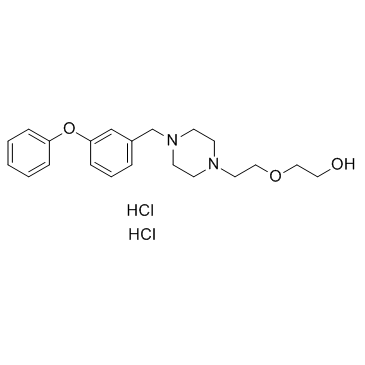1780259-94-0
| Name | ZK756326(dihydrochloride) |
|---|---|
| Synonyms | ZK756326 (dihydrochloride) |
| Description | ZK756326 dihydrochloride is a nonpeptide chemokine receptor agonist for the CC chemokine receptor CCR8. |
|---|---|
| Related Catalog | |
| Target |
CCR8:1.8 μM (IC50, in U87 cells) 5-HT2B:4.4 μM (IC50) 5-HT1A:5.4 μM (IC50) 5-HT6:5.9 μM (IC50) 5-HT5A:16 μM (IC50) 5-HT2C:34.8 μM (IC50) α2A:<20 μM (IC50) |
| In Vitro | ZK 756326 inhibits the binding of the CCR8 ligand I-309 (CCL1), with an IC50 value of 1.8 μM. ZK 756326 is a full agonist of CCR8, dose-responsively eliciting an increase in intracellular calcium and cross-desensitizing the response of the receptor to CCL1. ZK 756326 stimulates extracellular acidification in cells expressing human CCR8. Binding competition assays are performed on a series of other G-protein-coupled receptors to determine whether the interaction of ZK 756326 is specific for CCR8. In these assays, ZK 756326 is tested at 50 μM for inhibition of radiolabeled ligand binding. At this concentration, ZK 756326 shows >28 fold specificity for CCR8 compared with 26 other GPCRs, all with IC50 values of >50 μM. There is less selectivity when ZK 756326 is tested against the serotonergic receptors 5-HT1A, 5-HT2B, 5-HT2C, 5-HT5A, 5-HT6, and the adrenergic receptor α2A, in which IC50 values of 5.4, 4,4, 34.8, 16, 5.9, and <20 μM (at 20 μM 65% inhibition), respectively, are observed. The compound is unlikely to be an agonist on these biogenic amine receptors, because when tested at concentrations up to 10 μM on a representative receptor, 5-HT1A, it shows no agonist activity in a GTPγS binding assay[1]. |
| Cell Assay | U87 MG cells expressing CCR8 are plated on poly-D-lysine-coated black 96-well plates at 10,000 cells/well and are cultured overnight. Cells are then loaded with Calcium 3, a Ca2+-sensitive non-wash fluorescence dye, for 60 min at 37°C in Hanks' balanced salts solution containing 20 mM HEPES, 3.2 mM CaCl2, 1% (v/v) fetal bovine serum, and 2.5 mM probenecid. Changes in intracellular free-Ca2+ concentration are measured with Fluorometric Imaging Plate Reader (FLIPR 3) immediately after the addition of agonist at room temperature. Cross-desensitization experiments are performed by a first addition of the agonist (CCL1 at 30 nM or ZK 756326 at 3 μM), immediately followed by a second addition of 100 nM CCL1[1]. |
| References |
| Molecular Formula | C21H30Cl2N2O3 |
|---|---|
| Molecular Weight | 429.38 |
